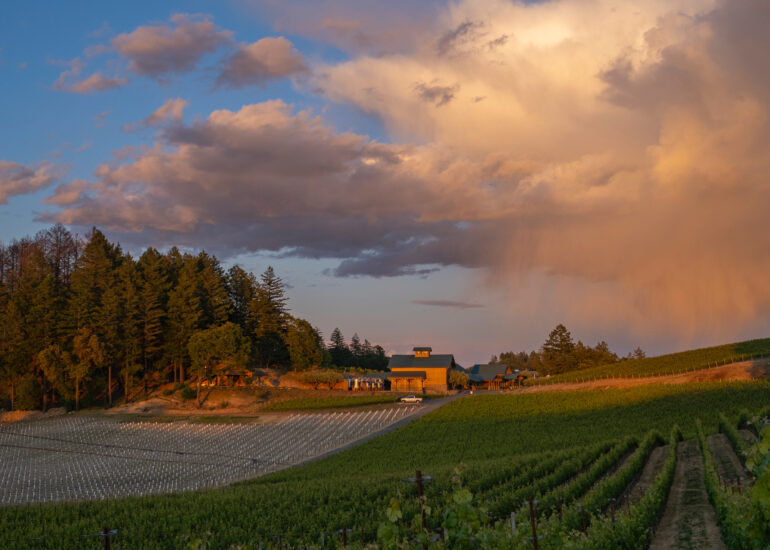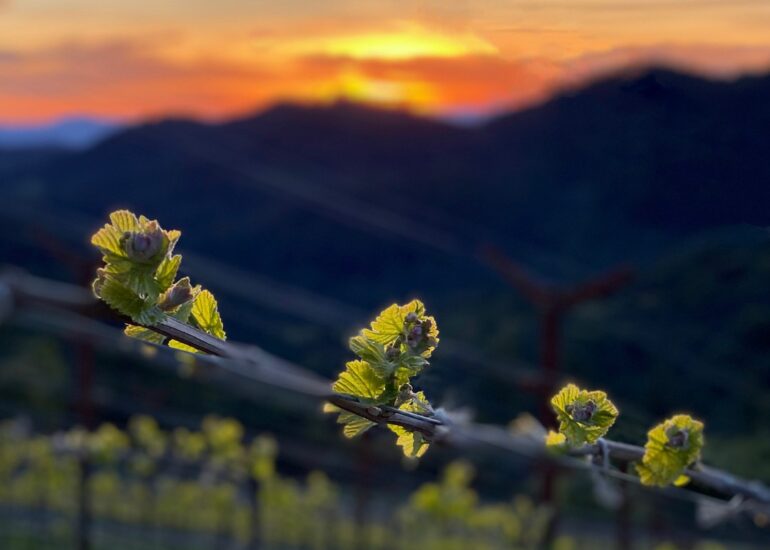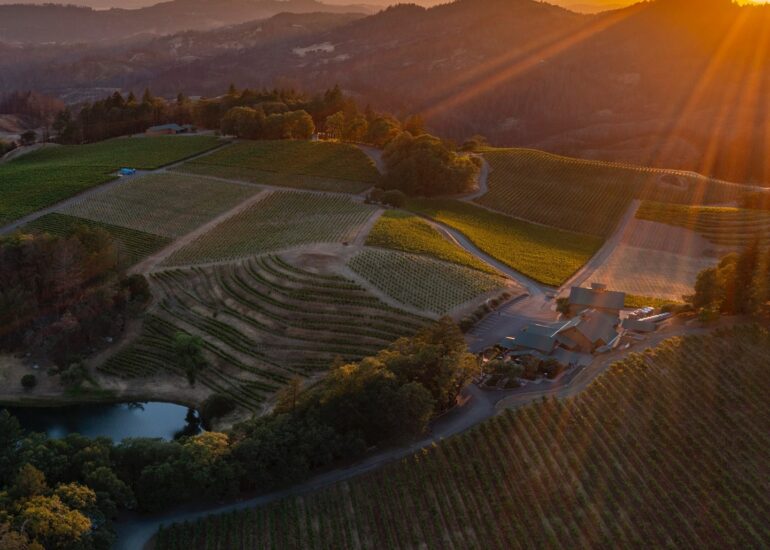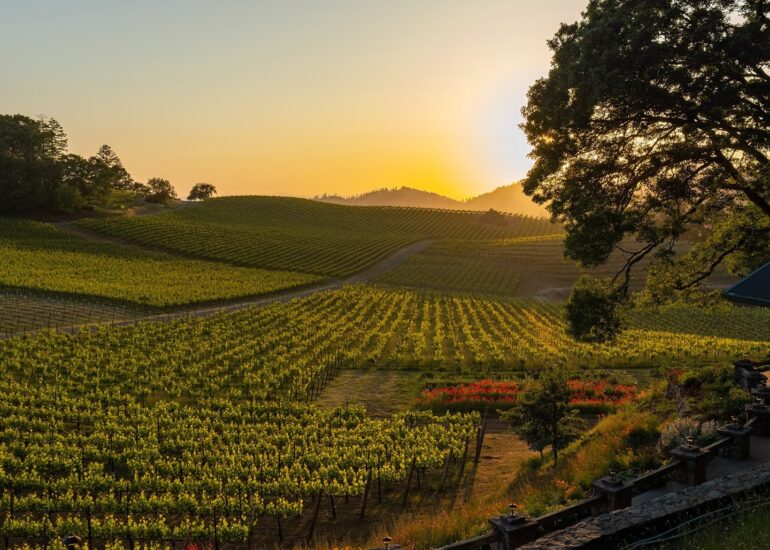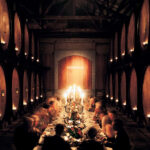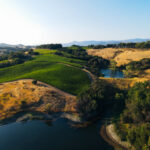Taking Pride
Winemaker Interview
Taking Pride
A conversation with Sally Johnson of Pride Mountain Vineyards on Napa's Spring Mountain
Mountaintop Winery Takes Pride in its Command of Elevated Site Diversity
An Interview with the Lead Winemaker of
Pride Mountain Vineyards
One striking fact with which visitors to Pride Mountain Vineyards are immediately met is that the 235-acre estate actually straddles the line between the two otherwise distinct appellations of Napa and Sonoma. But while having grapevines and production facilities located on either side of that border might present a logistical challenge or two, its position at the very top of Spring Mountain allows the winery to very clearly assert its identity by virtue of its unwavering focus on elevated terroir. The advantage of raising vines at that altitude, coupled with the inherent diversity of soil, aspect, and microclimate, empowers the winemaking team at Pride to craft wines with an alluring combination of character, richness, and longevity that few other producers can accomplish with estate vineyards. Along with its premium Merlot that first garnered media attention and established its name, Pride has since developed and distinguished its portfolio in further dedication to expressing a true sense of place. I met and spoke with Pride’s lead winemaker, Sally Johnson, to get more of the story behind this producer’s handcrafted wines of intensity and nuance.
Pride Mountain Vineyards began with the vision of Jim and Carolyn Pride who, in the hopes to indulge their fervor for farming, purchased the historic Summit Ranch in 1989. Their discovery of the site’s capacity to produce extraordinary wine shifted their focus from a casual and secluded agricultural lifestyle to a focused and quality-driven winegrowing commitment. Even after Jim’s death in 2004, the family continues his legacy — one steeped in his mantra to “participate in quality.” In doing so, they’ve proven that Pride is not only a name, but an attitude arising from the very dedication that first earned the brand its recognition. And as I quickly discovered during my tour of the vineyards, caves, and cellar, pride is also a feeling that runs through the entire winemaking team whose leader managed to showcase not only these wines of distinction but also the very land from which they came.
— Nikitas Magel
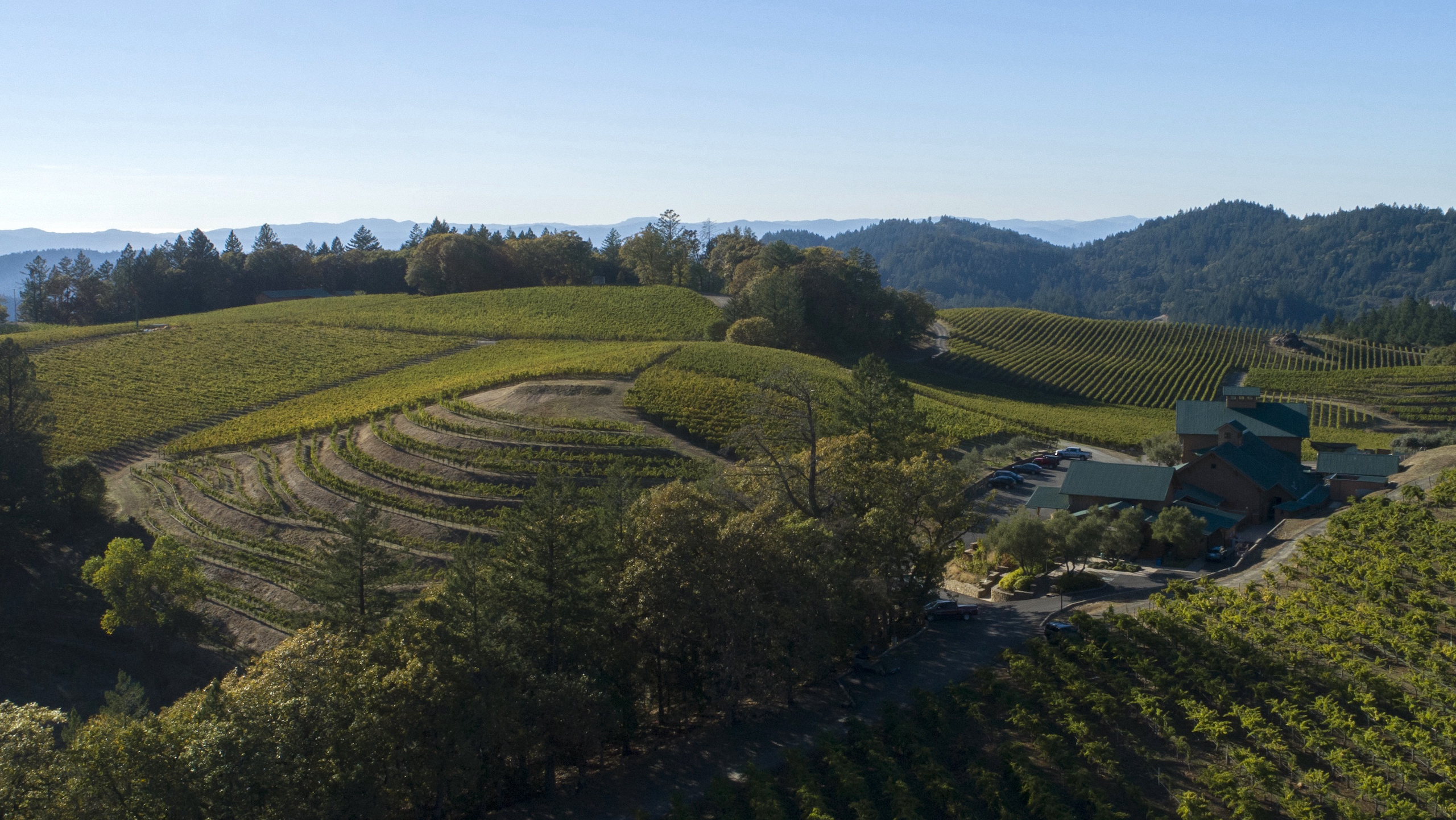
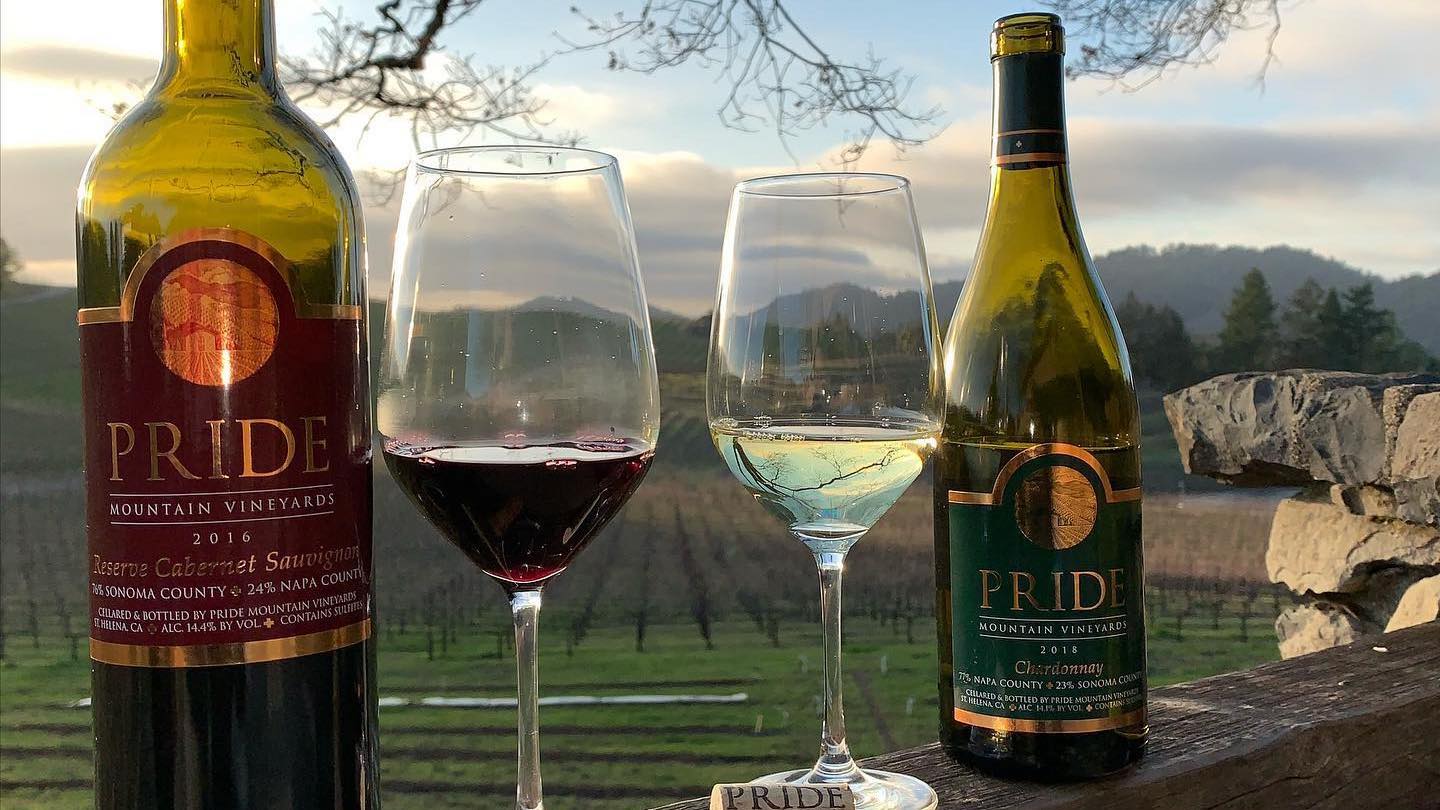
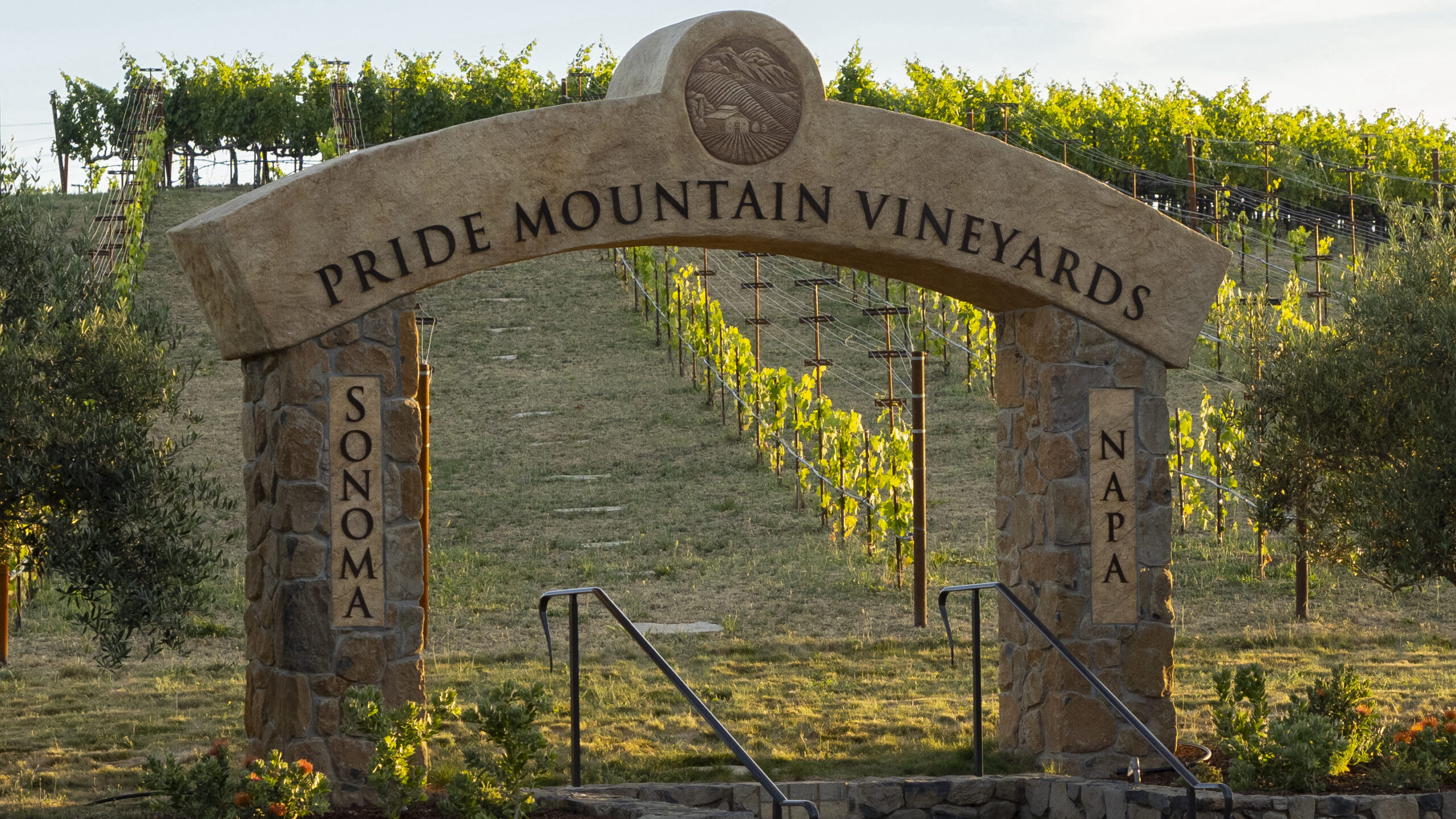
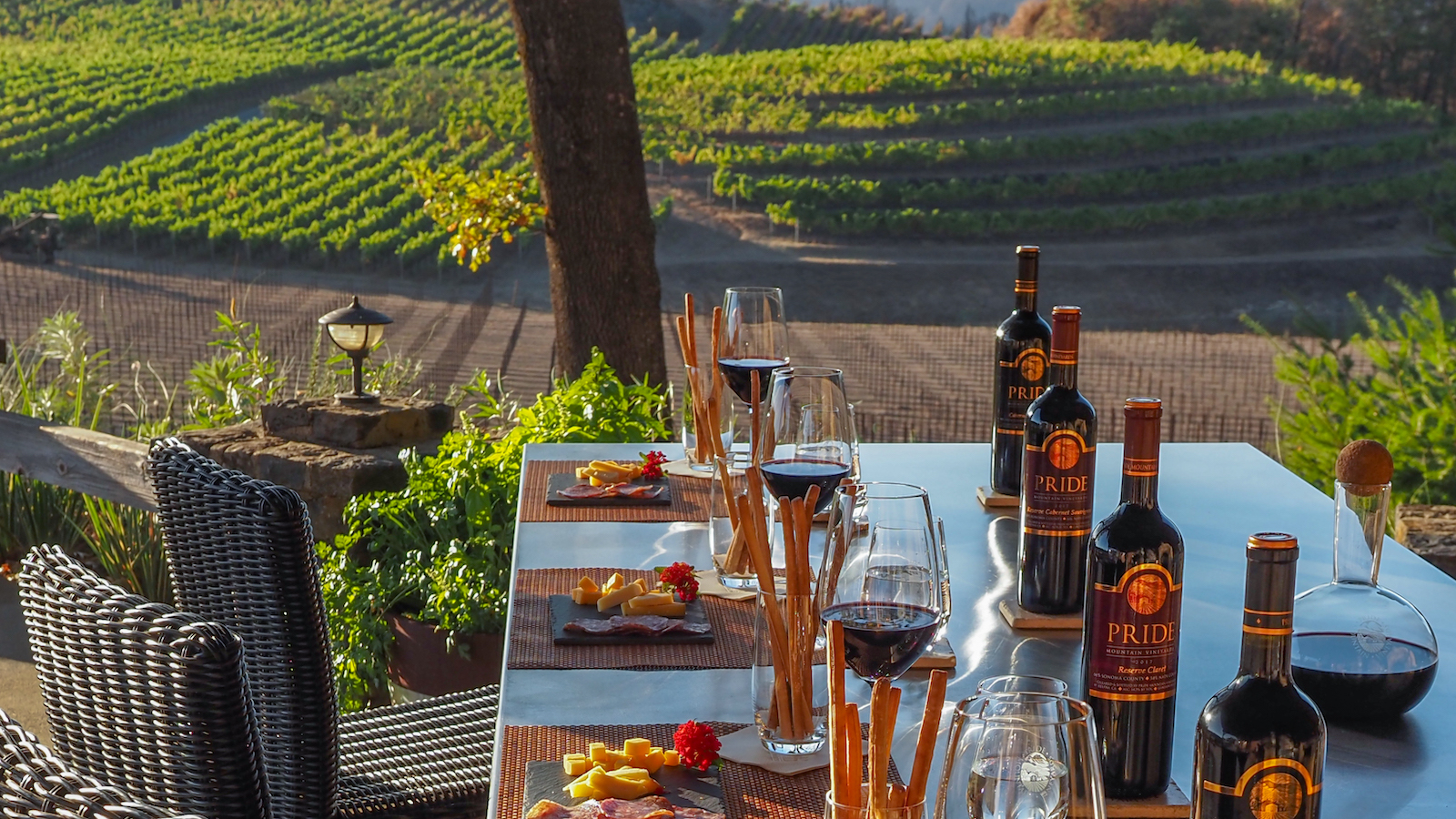
Straddling the Line
Nikitas Magel: How would you characterize the terroir here at Pride and how does it compare to the rest of Spring Mountain as an appellation?
Spring Mountain District overall is a really diverse appellation, so it’s hard to come up with rules that apply here in general. For one thing, there’s the elevation. There’s a huge difference between a winery located down at the bottom of the hill and where we are, which starts at 1,700 feet and goes all the way up to 2,200. We don’t get the morning fog the way some lower wineries do, nor do we get the extreme heat in the middle of the day. The other thing about Spring Mountain as an appellation is that there’s really not many vineyards planted here; there’s still a lot of natural woodland in the district, with vineyards being just little pockets that peak out. As a result, those vineyards have many different exposures with all kinds of little dips and grades, making it a very diverse and unique place as a whole. Here at Pride, we have many different combinations of rootstock, clone, and variety to really take advantage of that diversity. There are basically two main families of soils here. One developed when this mountain range was originally created by plates colliding and thrusting up from what was once the ocean floor: quartz sandstone that’s sandy and very well-draining. The other family of soils come from Mount Saint Helena, which erupted about 10,000 years ago; most of those are heavier red volcanic, moist, clay-based soils. And knowing these soils types is crucial because it’s very important to match rootstock and variety to those soils, since vigor is extremely different in one versus the other.
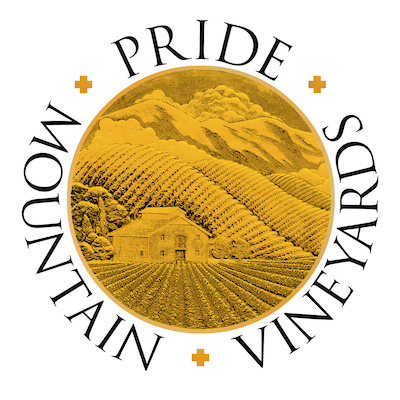
NM: Another unusual feature of Pride Mountain Vineyards, and one that I find really curious, is that your vineyards and your production facilities are both in Napa and in Sonoma — you literally straddle the county line! Tell me about that and how it has affected your marketing.
SJ: Most of our wines are actually a blend of wine from Napa and Sonoma, just because the vineyards are about 50/50. We make some that are 100% Sonoma, some 100% Napa, and most are a blend of the two where we’ll break the percentage out on the label, whatever that happens to be. Logistically that means we have to be very accurate with our record-keeping and those percentages; there’s no leeway. But we do straddle the county line and the biggest way that it affects us is that we can’t label our wines as “Estate” or “Produced and Bottled by” even though they are, because according to the TTB our wines are transferred in bond from one winery to another, so we’re treated as if we were negociants buying bulk wine and blending it up. But that’s another great thing about having our facility here and having 75% of our business being direct-to-consumer: we can tell story and show people the county line and show them the property. It becomes something that’s fun and unique.
Pushing the Portfolio
NM: And how have consumers come to know Pride Mountain as a brand? What would you say really established its reputation and how has that evolved?
SJ: Merlot was our flagship wine in the beginning and what the winery’s reputation was really built on. It was the first wine that was on the Wine Spectator’s top 100 list and it earned high scores from Robert Parker, creating a good deal of interest in Pride. But really, both Merlot and Cabernet have always been our larger production wines — though each one is under 5,000 cases, so we’re pretty small. Those were the two main varieties that consumers came to associate with us initially, with Merlot being the one that got people very excited. I would say that now our Cabernet and Merlot have a dual flagship role. We also make a very small amount of Cabernet Franc, which is a wine that’s highly sought-after — I think we have a great spot for that variety. And so, generally, we’re a red wine house and our mountaintop estate really drives the way the wines turn out. They’re very concentrated, big, and tannic — but they have a ton of fruit to really back that up, so I don’t think they’re one-dimensional in terms of being unapproachable early on. We try to take a dual approach of making wines that are ready to drink now but are also very ageworthy. We also make some reserve wines that have given Pride its cult status among some people who seek out those types of wines, which we sell through our mailing list and have helped build the mystique of Pride.

NM: Even as the red wines comprise the flagship of Pride, the white wine program seems to have really developed in recent years. Would you say that part of the portfolio is going through an evolution?
SJ: The Chardonnays have never been a huge part of the Pride portfolio; they’re in very small production since we’ve always been known as a red wine house. But now we’re trying to elevate the level of the whites. Although the Viognier has always been phenomenal in my opinion, with the Chardonnays we feel that there are some things we can do to add some complexity and make them a bit more modern in their approach — they used to be pretty heavily oaked and with full ML, whereas now we’re moving towards slightly higher acid, using some Burgundy-isolate yeasts and just really trying to make wines with a bit more finesse. We make two Chardonnays and there’s a real contrast between them, where you’ll see opposite ends of the style spectrum. One is the only one not from our estate, our Napa Chardonnay (100% Carneros fruit). This is the wine that we wanted to make in a more floral, fruit-driven and higher acid style with less new oak and less malolactic; it’s a bit more Burgundian. We really felt that Carneros was the place to go for that type of fruit, Sunset Atop Spring Mountainsince we’re just a little too warm up here to make wines in that style. It’s so much warmer up here that we get more richness and more flavors of banana, nectarine, and pear — like in our Vintner’s Select Chardonnay, which is from our estate. And that’s a wine that’s released later since it’s intended to be bottle aged more before consumption. It’s a wine with added barrel fermentation and a higher level of ML, so it’s bigger, richer, more hearty, and seems to need to bit more time to come together.
Varieties in the Vineyard
NM: What have you learned from the crafting of these two very different styles of Chardonnay, and how has that affected your decision-making in the vineyards?
SJ: I think the most important lesson here is that vineyard site is the main factor that drives wines. I couldn’t successfully make this higher acid style of wine (our Napa Chardonnay) using grapes from our own property. [If I tried to do so,] I would actually be shorting the potential of those grapes to make the wine style really suited to them. I can’t fit a square peg into a round hole, so to make this leaner and more Burgundian style of Chardonnay, we really needed to source fruit that was planted in an area that would produce that kind of grape. Whereas the Chardonnay we’re producing from our own property just naturally wants to be produced in a fuller style. Even if I picked those grapes three weeks earlier so they’d have a lower brix and higher acid, they would still never make a wine like the [leaner, brighter] style from Carneros. There are some differences in the yeast I use for the two wines, but mainly it’s a matter of understanding what their [respective] vineyards are producing and providing me, and then tailoring my decisions to fit the grapes and what the needs of those grapes are.
NM: In making these Chardonnays, have you discovered anything new that might have compelled you rethink your prior assumptions or understanding of the varieties?
SJ: I think that Chardonnay is really a winemaker’s wine, because there are so many stylistic choices and it’s so heavily influenced by those choices — the yeast that’s used, the pH and amount of acid, the lees stirring, the barrel type — much more so than reds. Even though all of those things affect them, too, red wines have such an overpowering character and identity on their own. Whereas with Chardonnay, manipulation is really key; there’s a lot that you can do, a lot that you can play around with. Barrel fermentation is great, too, because then you can have thirty different barrels and try various things with each barrel: multiple strains of yeast or ML, multiple types and ages of barrels, different lengths of stirring and sitting on the lees. It’s kind of like a big jigsaw puzzle at the beginning before any grapes are picked. Then as you assemble those pieces, you can start to see the image being revealed — that’s really satisfying for me!

NM: Speaking of risks, you also produce a Syrah, which isn’t common up on Spring Mountain. What issues do you face in doing so, which you feel are unique to this site?
SJ: Syrah is a wine that we’ve not been known for. In fact, we make only 300-600 cases of it; it’s very small production. And part of the reason is that Syrah just hasn’t reached the level of popularity that people predicted it would. So, while we’d love to make more Syrah, I’m not sure the market demand is there to support it. Syrah is also a very challenging wine to make, more so than Chardonnay. I think that it can be very boring if it’s not grown in the right environment and if it’s not really pushed both in the vineyard and in the winery. It’s a very vigorous vine, so it can grow uncontrollably — especially if there’s any available water. Our Syrah gets almost no irrigation, and up here that’s very extreme because our soils already don’t hold much water; there’s no water table since it’s so rocky and the water just drains right through. As our vineyard consultant says, we want to “push it until it screams” — and then we’ll give it just a bit of water to keep it from totally falling apart. And that’s the same sort of environment that grapes are grown in the Rhône valley: you’ll see these vineyards that are planted just in cobblestones where there isn’t much water for them, and the vines themselves are tiny. Otherwise, Syrah planted in any type of normal dirt will be a very large vine with a lot of vigorous growth. So, it really takes a very stressful environment to get it to express those delicious flavors of spice and blueberry, otherwise it can be a monotonous wine. We do a lot in the vineyard to really push the vines, and from there we pick very ripe and then use no new oak in the barrel aging. And we keep it in that neutral oak for only ten months, not a really long time.
Also, I think it’s important with Syrah not to rack it too much, not to get too much air in there; you want a somewhat reductive environment in the barrels because all of these exotic aromas can combine together to form a really appealing spicy berry profile. It’s a wine that I drink a lot because it tends to be a medium-weight wine that goes with a number of different foods. Plus, it’s so variable; there’s cooler-climate Syrah that’s very peppery, warmer-climate Syrah that’s very brambly, and then everything in between.
NM: Cabernet Franc often runs the danger of being too leafy. Yours definitely has an herbaceous character but it’s an attractive one that’s beautifully balanced with very expressive fruit.
SJ: Not many people produce a varietal Cabernet Franc; it’s a very challenging variety to grow. It has to be planted in the right spot because it’s actually a very late-ripening variety, even though there’s a misconception that it’s earlier-ripening. If it’s planted in a cool site, it just won’t get ripe enough. And even in the right spot, it really needs to hang longer. We pick ours later than much of the Cabernet Sauvignon since it needs much more time to lose that herbal tone. It also varies with vintage conditions; in some years it’s more similar to the Merlot, in others more similar to the Cabernet. It’s sometimes defined by red-toned fruit — red cherry, strawberry, plum — but in other years more blue fruit. We always try to push it far beyond the green tone it can otherwise get if it’s not ripened correctly. Some of the [Cabernet Franc] wines from the Loire Valley, for example, are herbaceous or even green, and that works well for the style of wine that they’re trying to produce. In California, though, I think it’s hard to bottle any wine that’s not fully ripe and expect wide support for that style of winemaking; it would be so contrary to what most producers are doing and what most critics are looking for, and just not something generally accepted for California. And that’s probably because we have a warmer climate and are fully capable of getting our wines much riper.
Pushing Limits, Holding Back
NM: Merlot and Cabernet Sauvignon are what Pride is known for. What is it about these wines that sets them apart from other Bordeaux varietal wines in this region?
SJ: Pride was one of the first wineries to really push the limits of ripeness and start picking grapes based on flavor rather than sugar levels. Bob Foley, our founding winemaker, along with some of the other great winemakers of his generation, were really the ones who initiated that revolution in practice, which has now been adopted by all of Napa Valley. So, our style is very ripe without being overripe; we pick when the grape seeds start to turn brown and become crunchy, and when the grapes themselves start to get a concentrated fruity flavor and ripe tannins. For that reason, our wines can carry a lot of tannin without being grippy because those tannins are very ripe. Also, this being a mountaintop location, the tannins are driven by the fact that we’re growing these wines in vineyards with no topsoil and under extreme water stress. And that yields small berries that have more tannins (since those tannins are in the skins of the berries and there’s not as much juice to dilute that down). For those reasons, our wines are very long-lived and made to be aged. But aside from that, it’s really the diversity of the property that makes these wines different. We don’t try to pigeonhole our wines; we let each vintage to express it’s own unique character, and they are very different. Being located on a small spot like we are, there’s no hedging of our bets — we don’t get fruit from other areas of the valley, so whatever the conditions are here at this vineyard location, it affects every single grape that we pick. And we can have big differences in vintage. But even with those variations there’s still a core of Pride fruit that runs through these wines — flavors of blue fruit, coffee and cocoa, and a mouthfeel that’s very rich and unctuous.

NM: Has making these Bordeaux varietal wines for Pride done anything to alter your understanding or prior assumptions about Merlot or Cabernet?
SJ: As far as winemaking, I wouldn’t say we’re doing anything drastically unique; what we do in the winery is fairly simple. It’s the picking of the grapes that’s really the most important decision that we make and we let those grapes drive all of our decisions in the vineyards. With the sheer diversity of the soils we have here, the different aspects and exposures, and the winds that come in on some areas of the property, we really do a lot to manage each block — section-by-section and even vine-by-vine, in some cases. In fact, we’ve done a lot of experiments with things like early-season leaf-pulling to get more sunshine on the grapes even before bloom and before the berries are even developing. There’s also been some evidence to suggest that having looser clusters, which increases air flow during ripening, gives the grapes greater concentration of flavor and color. And so, we play around with things like to get each block really dialed in. But at the same time, it’s not like I have in my head a rule book of steps that I take or guidelines that I follow in order to make the wines; it’s really more of an overarching philosophy. Ultimately, I’ve adapted things I’ve learned from other environments to fit this one because it’s totally unique.
Challenges and Satisfactions
NM: In crafting wines for Pride from these vineyards on Spring Mountain, what would you say are the things you find exciting and, conversely, what aspects do you find challenging?
SJ: The greatest thing for me about producing wines from here on Spring Mountain is that we’re entirely estate-production, so that with every block and every row I see these vines throughout the year. Our vineyard manager lives here on the property, and he and I talk two or three times a day about what’s going on in the vineyard. So, I’m able to be very actively involved in how the grapes are grown from start to finish. And I really prefer that to having to drive all over and work with contracted fruit, and trying to get the owners and growers to manage the fruit the way I’d like to see it done. Another thing I enjoy here is the quality; I think we have some really unique vineyards here. One is what we call our Rock Arch vineyard block, the oldest one on our property. It’s unique in part because of its vertical cordons; instead of training the vines out like a T, we’ve trained them up. It was a vineyard that was planted from cuttings taken from a couple of vineyards down in [the valley of] Napa. Nobody knows exactly what the clone is, but it’s unbelievable and totally distinctive; it produces a blue-black fruit that’s very concentrated and can be very tannic, and is always the last thing to be harvested.

NM: Bringing it all full-circle, how do you feel that Pride integrates into the overall identity of the Spring Mountain appellation?
SJ: I don’t know if there ever will be a single identity for Spring Mountain. It’s mainly known for Cabernets, but the character of those Cabernets can vary drastically. There’s a lot of great Merlot here, too. But I don’t think this will ever be like the smaller, well-defined appellations where you know what to expect from the wines that come from there. I think Spring Mountain will always have great diversity.
Yet in the end, it’s the command of that very diversity that has allowed Pride’s winemaking team to continue to articulate the brand’s identity and further strengthen its renown as a producer of mountain-grown wines of allure, character, and longevity. To learn more about this producer, its story, and its portfolio of wines, visit Pride Mountain Vineyards online.
Interview by Nikitas Magel
Photos by Pride Mountain Vineyards

Comments are closed.

